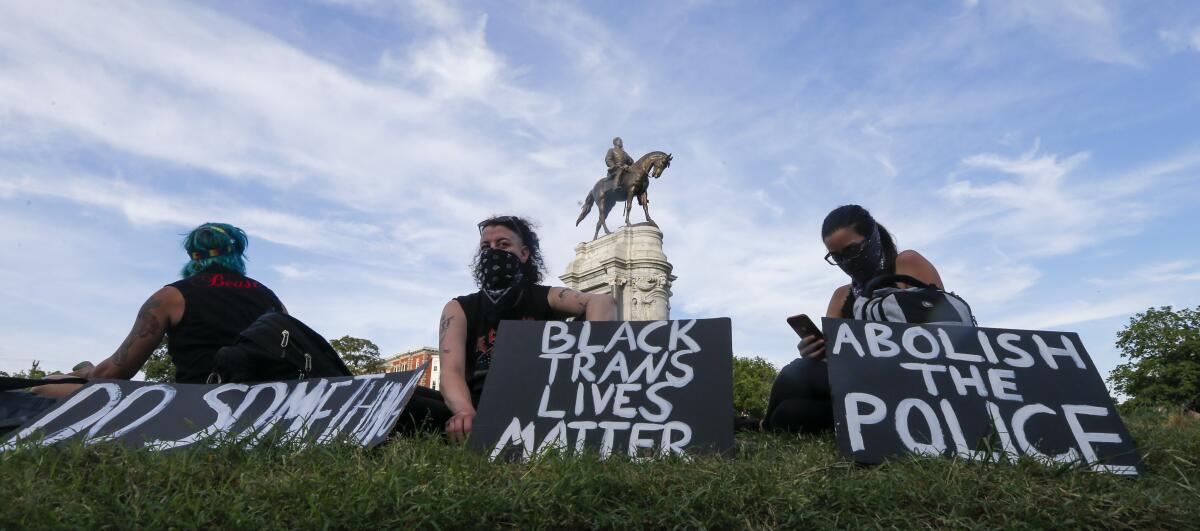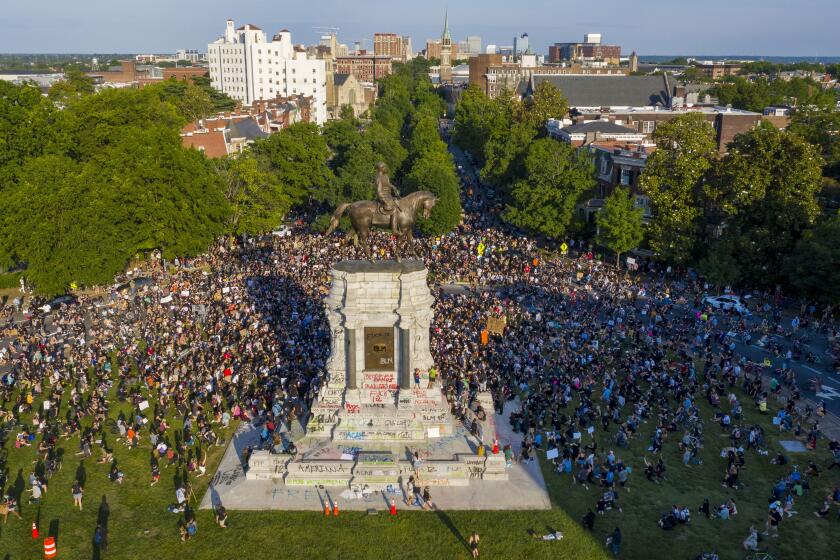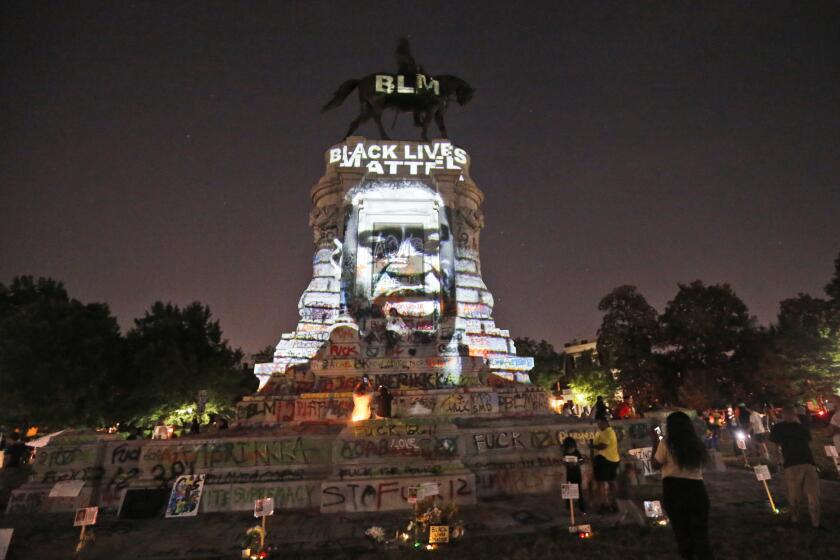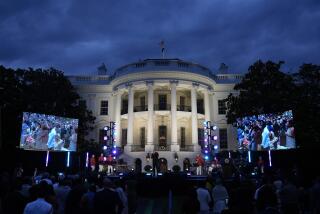Confederate monuments: Why the National Trust for preservation changed its stance

In the wake of global protests and civil unrest after the killings of George Floyd, Breonna Taylor and Ahmaud Arbery, the National Trust for Historic Preservation for the first time has expressed support for the removal of Confederate monuments from public spaces.
The 70-year-old preservation organization, a privately funded nonprofit dedicated to saving historic buildings and spaces, on Thursday backed the Black Lives Matter movement and acknowledged Confederate monuments âsometimes serve as rallying points for bigotry and hate today.â
Recent protests have triggered a wave of Confederate monument take-downs in Alexandria, Va., and Birmingham, Ala. In at least six states, more than a dozen statues and symbols of the Confederacy reportedly have been damaged or defaced.
Southern mayors and Virginiaâs governor are striking while the iron is hot, using the unprecedented moment to get it done.
Although some longstanding Confederate monuments may be designated as historic, the statement continued, âthe National Trust supports their removal from our public spaces when they continue to serve the purposes for which many were built â to glorify, promote and reinforce white supremacy, overtly or implicitly.â
The statement Thursday marked a change from the organizationâs previous stance on Confederate monuments.
After the violent 2017 white nationalist rally in Charlottesville, Va. â sparked by a proposal to remove a statue of Confederate Gen. Robert E. Lee â the National Trust called for the monuments to be âre-contextualized to provide information about the war and its causes ⌠rather than silence the past no matter how difficult it may be.â
To learn why the organization decided to shift its position, The Times spoke to National Trust President Paul Edmondson. The interview has been lightly edited for length and clarity.
What went into the decision to release this statement in support of removing Confederate monuments?
The killing of George Floyd has caused every organization and institution to look at their own policies, practices and positions. The second thing is that the issue of monuments, particularly Confederate monuments, is at the top of the news. We thought it was about time given those two factors that we took a second look at the positions that weâve taken in the past on Confederate monuments.
What were those previous positions on Confederate monuments over the years?
We made a statement in 2015 after the murders at Emanuel AME church in Charleston which was very similar to the statement in 2017 after Charlottesville. And those statements basically say that communities will be looking at these issues and we encourage them to consider whatâs called recontextualizing them.
In other words, putting signs, plaques and exhibits and derivative materials that make clear what they are. But really we did not take a position on whether they should be removed. We thought long and hard about that and decided that it was really important for us to go ahead and make a firmer statement that when theyâre used for the purpose of which they were intended â to glorify, promote and reinforce white supremacy overtly or implicitly, we support their removal. So we wanted to go ahead and make an affirmative statement.
Given the National Trustâs 70-year history, why is yesterdayâs statement significant, or maybe even controversial, for the organization?
The thrust of our history and what we do is to preserve historic places, so automatically the question has been raised: How can a preservation organization support the removal of something that might have been there 100 years or even longer?
Our response is that our goal is not to freeze places in time. We donât want things preserved in amber. They live in our current life and current existence. Our efforts over the years have really been to manage change, to respect history and to make sure that communities reflect the history that they have.
But when thereâs a particular aspect that is really a symbol of racial supremacy and has affected the African American population, I think as preservationists we can say that this is not necessarily something that needs to stay. In response to the issue about erasing history, also I think that removing these monuments does not really remove history. We certainly encourage their removal to museums or other locations where they can be properly interpreted as to exactly what they are, why they were put up.
Thereâs plenty of documentation about our racial past and Jim Crow and these monuments. So we donât really think that weâre erasing history.
Since the founding of the Black Lives Matter movement, there have been cycles of unrest after police brutality against Black people. What was it about George Floydâs death in particular that caused this change?
Like many institutions in the United States, the really horrific death of George Floyd has been a wake-up call to institutions and organizations. It really has been to the National Trust to say that we have not valued African American history and then made that a part of our work. I want to be clear that we have through such programs as the African American Cultural Heritage Action Fund, which is one of our premier programs and has invested this significant amount of money and time and effort working with communities around the country to preserve places that are historic and of meaning to African American and other diverse communities.
Itâs not as if we were ignoring this part of our history. But in the last month or so since the George Floyd killing, I think itâs true with us, but I think itâs true with America generally, that thereâs a real reexamination, and a healthy reexamination, of the core issue of embedded white supremacy.
We and other organizations have a responsibility to take this opportunity â unfortunate as it was at its inception â to deal with these issues and deal with them forthrightly.
States and cities across the U.S. are removing Confederate statues amid protests over systemic racism and violence and the killing of George Floyd.
Was there an internal revolution within the organization to get to this point? Was there a lot of debate or discussion within the organization before the release of the statement?
I donât think I could describe it as a lot of debate and discussion. There was certainly a lot of attention put on this, but I think fairly quickly there was a consensus within the organization that this was an issue that we should tackle. Itâs a hard issue. But it was the right thing to do. There certainly was not within the organization any dissent, I would say.
The National Trust is a national organization; we have members across the country. I am sure that this will please many members and displease others, and weâll bear the consequences of that decision. But we do think this is the right decision.
According to an FAQ page, the National Trust doesnât support the spontaneous removal of Confederate monuments. What should that process look like and by when should the monuments be removed?
We donât support the spontaneous removal by violence. For one thing, itâs dangerous. There have been injuries and one very serious injury with these types of incidents. Weâre only talking about monuments in public places. These are monuments and courthouse squares in front of municipal buildings in public parks. We think that itâs the responsibility of the governmental entities that are responsible for those statues and really have jurisdiction over them to make those decisions.
We would like them to be made with input from the public. This goes also with what to do with them and what to do with the space after theyâve been removed. As to the time it takes, I canât really say. Each statue, each monument is unique. They all have to be examined.
But I do understand the frustrations to cause some of these spontaneous actions to remove them. A frustration that has taken so long for communities to address this issue, and we really urge communities that itâs time to take a close look into restitutions.
After removing the statues or the monuments, what comes next?
That is a decision that should be made at the community level and made in a way that embraces all voices within the community. Inclusive and hopefully with advice from design experts, landscape experts and possibly artists, because I think this creates an opportunity to replace these statues with something new and unique that really represents the communityâs values.
More to Read
The biggest entertainment stories
Get our big stories about Hollywood, film, television, music, arts, culture and more right in your inbox as soon as they publish.
You may occasionally receive promotional content from the Los Angeles Times.













